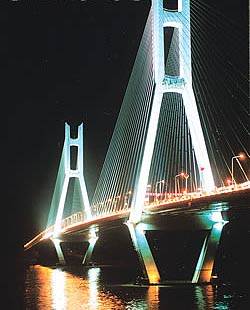Hubei has looked on the acceleration of transportation, telecommunications and energy construction as an important basis of economic construction and opening-up. It keeps a rapid step in road, railway, port, airport, post and telecommunications, power plant and electricity network construction work.

No.2 Changjiang Bridge of Wuhan
Communications and Transportation
Hubei is the largest inland hub of communications in China with the well-developed communications and transportation. Wuhan, the capital of Hubei, is called "a thoroughfare leading to nine provinces" and has been the center of communications and transportation ever since the ancient times. With the Shanghai-Chengdu expressway and the section of Beijing-Zhuhai expressway in Hubei as the backbone, with eight national roads such as No. 107 and No. 318, and many provincial roads as the ties, the high way network has been formed, which links every corner of the province. Wuhan Changjiang Bridge is the first bridge across the Changjiang River in China. Up to now, there are thirteen bridges on the Changjiang River in Hubei, some of which are still under construction. This number ranks first in China.
The railway network established in Hubei radiates in every direction. The Beijing-Guangzhou Railway, the Beijing-Kowloon Railway and the Jiaozuo-Zhicheng Railway run from north to south across the province, and the Xiangfan-Chongqing Railway and the Hankou-Danjiangkou Railway from east to west. Wuhan Railway Center is one of the large railway centers in China where the Beijing- Guangzhou Railway, the Hankou-Chongqing Railway and the Wuhan-Jiujiang Railway join together, and connects the Beijing-Kowloon Railway through the linking lines. Wuhan Railway Center plays a pivotal role in the national railway network. The Xiangfan Railway Center is another important railway center. Starting from Wuchang, Hankou, Xiangfan and Yichang, passenger trains are bound for the major cities throughout the country.
Hubei also has a well-developed inland river transportation. Wuhan Port is the second largest inland port in China, at which 10,000-ton cargo ships for both ocean and river navigation can berth. The passengers transported from Wuhan Port rank in front among the seaports and inland river ports throughout the country. There are three special docks for the foreign trade transportation along the Changjiang River, namely, Baihushan Port, Qingshan Port and Huangshi Port. 5,000-ton ships can berth at these docks throughout the year, and can sail directly to the Hong Kong Special Admin- istrative Region, Japan and some countries and regions in Southeast Asia. The Changjiang Shipping Group of China is the largest inland river shipping enterprise headquartered in Wuhan.
There are 7 airports in Hubei, among which Wuhan Tianhe International Airport is a first-class civil airport of China. Starting from it, 158 international and domestic air lines lead directly to 60 large and middle size cities at home and abroad with an annual transporting capability of 4.2 million passengers, and 120 airplanes taking off and landing on every day. The air routes to Hong Kong, Macao, Japan, South Korea,etc. have been opened up.
Post and Telecommunications
The three-dimensional communication network, with the optical cable as the main part, the digital micro-wave and satellite communication as the aux- iliary parts, has been established in Hubei. The opti- cal fibre communication connects tile whole province. Program-controlled telephones are popularized in rural area. The wireless calling network, the digital mobile network and tile Internet have been merged into people's daily life. The multi-media communication technology, the digital mobile communication technology of new generation and the wide-band accession technology, etc. have been gradually popularized. Telephone subscribers of the whole province total above ten million households. Large companies such as Telecommunications, Mobile, Unicom, Netcom and Railcom have started their business in Hubei. The Internet becomes popular rapidly in both urban and rural areas. The Intemet users through dialing have exceeded one million. The main web sites include Chutian Hotline, Wuhan Hotline, Jingchu News Web, etc.
The business offices of post and telecommunications are scattered all over the province. The postal services have extended to millions of households. The postal service work of Hubei Province is striding to- ward mechanization and modernization. The "Green Card Project" of postal service has been connected through internet with more than 50 cities in China. Wuhan Central Bureau of Postal Service is one of the seven large central bureaus of postal service as well as one of the eight large airmail-transferring bureaus in China. It is the largest distributing center of mails in the central-south.

